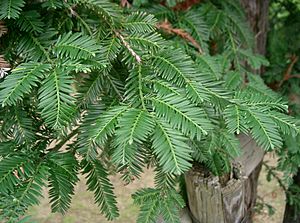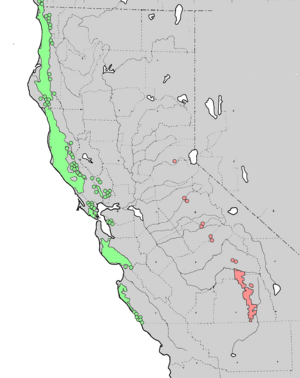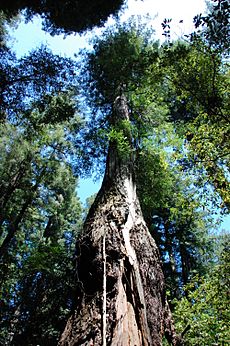Sequoia (genus) facts for kids
Quick facts for kids Sequoia (genus)Temporal range: Jurassic to present
|
|
|---|---|
 |
|
| Needles | |
| Scientific classification |
|
| Kingdom: | Plantae |
| Clade: | Tracheophytes |
| Division: | Pinophyta |
| Class: | Pinopsida |
| Order: | Pinales |
| Family: | Cupressaceae |
| Subfamily: | Sequoioideae |
| Genus: | Sequoia Endl., conserved name |
| Species | |
|
|
 |
|
| Natural ranges of Sequoia and Sequiodendron
green - Sequoia sempervirens
red - Sequoiadendron giganteum
|
|
| Synonyms | |
|
|
Sequoia is a type of giant tree known for being super tall! These amazing coniferous trees are part of the redwood family. The only kind of Sequoia tree still alive today is called Sequoia sempervirens. You can find these incredible trees growing naturally along the coast of Northern California and a small part of Oregon in the United States.
Sequoia trees are closely related to two other famous redwood types: Sequoiadendron (giant sequoias) and Metasequoia (dawn redwoods). Sequoia trees include some of the tallest trees in the world. They are also among the heaviest!
Scientists have found fossils of several Sequoia species that are now extinct. These ancient trees lived a long, long time ago. Some of these extinct species include Sequoia affinis from North America and Sequoia chinensis from China.
Contents
What's in a Name? The Story of Sequoia
The name Sequoia was first used for this type of tree in 1847 by an Austrian botanist named Stephan Endlicher. He never wrote down why he chose this name, so people have wondered about it for a long time!
Who Was Sequoyah?
The most popular idea is that Endlicher named the tree after Sequoyah. Sequoyah was a very smart man from the Cherokee people. He invented a special writing system for the Cherokee language. This system helped many Cherokee people learn to read and write. Since Endlicher was also a language expert, many people think he honored Sequoyah with the tree's name.
Another Idea: The "Sequence" Theory
Another idea is that the name Sequoia comes from a Latin word meaning "sequence." Some people thought the Sequoia tree was like the next step in a long line of ancient, giant trees that are now extinct. So, it was seen as the "next in a sequence."
However, some experts disagree with this idea. They say Endlicher probably didn't think of the tree in that way. He might have named it based on how many seeds were in its cones, seeing it as part of a "sequence" of different tree types. The true reason for the name is still a bit of a mystery!
Ancient History of Sequoia Trees
Sequoia trees have been around for a very long time! The oldest known member of the Sequoia family is Sequoia jeholensis. Its fossils have been found in China and date back to the Jurassic and early Cretaceous periods. That's millions of years ago!
How They Grew So Tall
By the late Cretaceous period, ancient Sequoia trees were growing in Europe, parts of China, and western North America. Scientists believe that even back then, these early Sequoia trees had already developed special features in their wood that allowed them to grow to amazing heights, just like the giant Sequoia sempervirens and Sequoiadendron giganteum we see today.
A Changing World for Redwoods
As the Earth's climate started to get cooler during the late Eocene and Oligocene periods, the areas where ancient Sequoia trees could grow began to shrink. Sequoia trees don't like frost because their tissues hold a lot of water.
By the end of the Miocene and beginning of the Pliocene periods, the Sequoia fossils looked exactly like the Sequoia sempervirens we know today. But as the cooling continued, Sequoia trees disappeared from Europe and Asia.
In western North America, they moved south into coastal Oregon and California. They survived there because of the heavy rainfall and mild weather. The rise of the Sierra Nevada mountains also kept them from spreading eastward. The Sequoia trees you see today are likely growing in the same areas they have been for a very long time!


